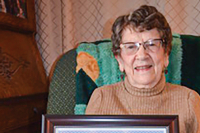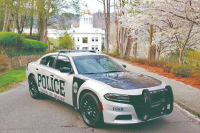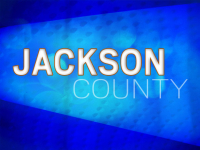Be prepared at the polls: Voting changes are coming in 2016
 The days of simply walking into a polling place and casting a ballot are over.
The days of simply walking into a polling place and casting a ballot are over.
New hurdles in place are not insurmountable, but voters who are unaware of the different requirements could run into problems on Election Day.
The new laws, which require voters to show photo identification before voting, will go into effect during the 2016 election.
The Haywood County Board of Elections — like many local boards across the state — is working on outreach efforts to prepare for the 2016 election.
“I want to prevent any hardships. My job is to remove the hurdles,” said Robert Inman, the director of the Haywood County Board of Elections. “This is going to be new and different, and it’s going to take time for people to adapt and adjust. I’m working to make the transition as seamless as possible.”
Related Items
The new voting process
The new voter ID laws mandate that the state board administer the photo ID requirements in a way that confirms a voter’s identity as accurately as possible. If the proposed rules are passed as is, here is how voting would go:
A “determination of reasonable resemblance” will be done when a potential voter first checks in at the precinct during early voting or on Election Day. An election official will check that person’s registration status and ask for a photo ID.
If the potential voter does not have an acceptable form of identification, they may cast a provisional ballot, which will be counted once their identification is confirmed. Inman said voters would have seven to 10 days after Election Day to return to the elections office with an acceptable form of ID for their provisional ballot to be counted.
If an election official at the poll determines the ID is not valid, is expired or that the photo doesn’t resemble the voter, that person may still cast a provisional ballot. The state board’s proposed rules don’t allow an election official to say that the photo on and ID does not resemble the person based on weight, hair features, facial hair, tattoos, makeup, medical condition or disability and printing qualities.
The name on the photo ID and the name on the voter registration also has to match or be “substantially equivalent” to be able to vote.
Precinct officials, or “judges of elections” will determine whether the photo on the ID matches the voter in front of them if an elections official refers a voter to them. The judges of election shall make their determinations based on the totality of the circumstances, construing all evidence in the light most favorable to the person presenting to vote.
If the name or address doesn’t match the ID and registration form, the potential voter will have the opportunity to update their name or address information before being allowed to vote.
Poll workers needed
More regulations will require more people to be involved during early voting and on Election Day. Inman is trying to prepare now for that increased need by recruiting more poll workers and working with the board of education to recruit student election assistants.
Anyone interested in becoming a poll worker, Inman said, should call the elections office or call one of the local political parties and ask them to add their name to their list. Each political party will submit its preferred list of precinct officials to the Haywood Board of Elections for final approval by August. Poll workers do receive compensation.
Inman said students could be helpful during the voting process by making sure voters waiting in line have everything they need to vote before they reach the voting booth.
“I don’t want people to stand in line and not have what they need,” he said. “But we need extra people to facilitate that.”
Not only would these students get compensated for their work, but also it would educate and engage them in the election process according to Inman.
Election changes go beyond voter ID
While voter ID has been the most debated change in the laws, several other changes have already gone into effect that voters should be aware of before the 2016 election.
Early voting days cut
The early voting period has been reduced. The early voting period was cut from 17 days to 10 days and will begin the second Thursday before Election Day. While the days have been cut, the law requires local boards of elections to offer the same number of early voting hours that were offered before the law changed.
Same-day registration eliminated
As of 2014, people can no longer register and vote during the early voting period. Voters must be registered at least 25 days before an election.
Teens can’t pre-register
Before the election laws were changed in 2013, 16- and 17-year olds could pre-register in high school and be automatically added to the voter rolls when they turned 18. The program is done away with under the new laws.
Absentee voting changes
Those who plan to vote absentee must now fill out an official board of elections request form that includes the voter’s name and address, date of birth, an ID number and the voter’s signature (or the signature of the voter’s near relative or verifiable legal guardian). Once the application form is received, the county board of elections will mail the voter a ballot. The voter has to complete the ballot and mail it back in the envelope provided — two witnesses or one notary public must sign it. The voter can also choose to return the ballot by delivering it to an election official at an early voting site during any time that site is open for voting.
No more straight-ticket voting
Voters will no longer be able to vote straight-ticket, meaning they must mark the ballot for their preferred candidate in each race they choose to vote in, instead of just checking Republican or Democrat.
Must vote at correct precinct
Provisional ballots will no longer be counted if they were cast by a voter outside of their home precinct. Voters must cast their vote in their assigned precinct on Election Day.
Citizens Awareness Program
The state will no longer have an annual “Citizens Awareness Month” designed to register voters and engage then in the electoral process.
More poll observers needed
In addition to the current two observers allowed at each polling place designated by the county political parties, the new law permits county parties to designate 10 additional at-large poll observers. The at-large observers must be residents of that county and would be able to attend any polling place in that county.
Paper ballots
The new law mandates that all voting machines must produce a paper record of the votes cast and provide a backup means of counting the vote that a voter casts. This will essentially ban touchscreen voting machines used by many counties in the state.
Less local control of polling hours
County boards of elections no longer have the authority to keep polls open an hour longer in extraordinary circumstances — that decision is now in the hands of the State Board of Elections. However, any voter who is in line to vote at the time the polls close will be permitted to vote.
Special election dates
The new law states that any local government special election must be held on the same day as a state, county or municipal general election.
What type of photo IDs will be accepted in 2016?
• NC driver’s license, learner’s permit or provisional license
• Special ID card (N.C. DMV ID card).
• U.S. passport.
• U.S. military ID (retired, active, dependents and civilian).
• U.S. Veterans ID issued by Veterans Affairs
• Tribal enrollment card issued by federally recognized tribe.
• Tribal enrollment card issued by a N.C. recognized tribe.
• Out-of-state driver’s license, only if the voter registers to vote in the county within 90 days of the election
Where do I get a photo ID?
Department of Motor Vehicles offices offer ID cards for customers who require a photo ID, but do not require a driver’s license. There is no fee for a voter ID card, or if a customer qualifies for another no-fee ID. The cost for a standard non-operator ID card is $10. An ID can be obtained from any driver license office, regardless of where you live.









